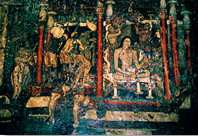Genres of Indian Painting
Indian paintings can be broadly classified as murals and miniatures. Murals are large works executed on the walls of solid structures, as in the Ajanta Caves and the Kailashnath temple. Miniature paintings are executed on a very small scale for books or albums on perishable material such as paper and cloth. The Palas of Bengal were the pioneers of miniature painting in India. The art of miniature painting reached its glory during the Mughal period. The tradition of miniature paintings was carried forward by the painters of different Rajasthani schools of painting like the Bundi, Kishangarh, Jaipur, Marwar and Mewar. The Ragamala paintings also belong to this school, as does the Company painting produced for British clients under the British Raj.
10 Murals

Mural painting is inherently different from all other forms of pictorial art in that it is organically connected with architecture. The use of colour, design, and thematic treatment can radically alter the sensation of spatial proportions of the building; in this sense mural is the only form of painting that is truly three-dimensional, since it modifies and partakes of a given space. Apart from its organic relation to architecture, a second characteristic of
mural painting is its broad public significance. The mural artist must conceive pictorially a social,
religious, or patriotic theme on the appropriate scale in reference both to the structural exigencies of the wall and to the idea expressed.
The history of Indian murals starts in ancient and early medieval times, from 2nd century BC to 8th – 10th century AD. There are known more than 20 locations around India containing murals from this period, mainly natural caves and rock-cut chambers. The highest achievements of this time are the caves of Ajanta, Bagh, Sittanavasal, Armamalai Cave (Tamil Nadu), Ravan Chhaya rock shelter, Kailasanatha temple in Ellora Caves.
Murals from this period depict mainly religious themes of Buddhist, Jain and Hindu religions. There are though also locations where paintings were made to adorn mundane premises, like the ancient theatre room in Jogimara Cave and possible royal hunting lodge circa 7th-century AD – Ravan Chhaya rock shelter.
